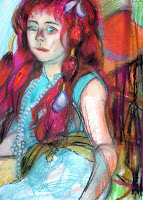



 I just read this great article about Philip Guston by Nicole Krauss in an old Modern Painters magazine (winter 2003). Krauss writes:
I just read this great article about Philip Guston by Nicole Krauss in an old Modern Painters magazine (winter 2003). Krauss writes:When Guston showed his first figurative paintings in October 1970 at the Marlborough Gallery in New York people came away shocked and even disgusted.
I'm fascinated by Guston's shift from Abstract Expressionism to Figuration. Evidently his rejection of Abstraction caused many of his closest friends to turn their backs on his new work, and it cost him his close friendship with the composer Morton Feldman (pictured here in 1965 with Guston). About this shift Guston proclaimed, "American Abstract Art is a lie, a sham, a cover-up for a poverty of Spirit! I got sick and tired of all that purity! I wanted to tell stories!"
Of Guston's transition to figuration, Krauss writes:
By 1968 the marks began to cohere into the first objects - a head, a shoe, a light bulb, a hand holding a pencil. It was as if a language was being invented from scratch. And not just any language, but one that came from the well of Guston's life: rope, like the one his father, a Jewish immigrant from Odessa, hanged himself with when Guston was ten...a light bulb, like the one that lit the closet where he first began to draw a year after his father's death; Klansmen, from a mural he did about the Scottsboro trial in the early 1930's that was destroyed by vandals; cigarettes, bottles of alcohol, paintbrushes, easels.
Many of the images he was now fixated on were things he'd painted two decades before and scraped out or covered up. 'I wasn't ready to accept it,' he said. It wasn't until the last decade of his life that Guston was prepared to see what his hand would make if he granted it freedom. (my emphasis)
And to quote the Cowardly Lion here, "What puts the Ape in Apricots? C - ourage." Guston sure had it.
Philip Guston
Philip Guston
Talking, 1979
oil on canvas, 174 x 198.1 cm
The Studio, 1969
oil on canvas, 121.9 x 106.7 cm
Back View, 1977
oil on canvas
Couple in Bed, 1977
oil on canvas, 206.2 x 240.3 cm







2 comments:
I love Guston's work. I've always felt that people shouldn't have been so radically startled at his shift from abstraction to representation. All the elements of his later work can be discerned in the clustered strokes and forms of his abstractions. And when you look at his early work, you see a clear link in subject and thought to the later things. In other words, people don't really pay attention when it comes to stylistic changes in an artist's work. They see the changes and miss the continuities. And there are as many continuities as there are disjunctions in Guston's work.
Yes. I am reading his daughter Musa Meyer's memoir right now. She writes about this.
Guston's life story is a tough one. I'm just a quarter way through the book, and so far he would flunk the course in being a good father...
Life is so complicated.
Post a Comment